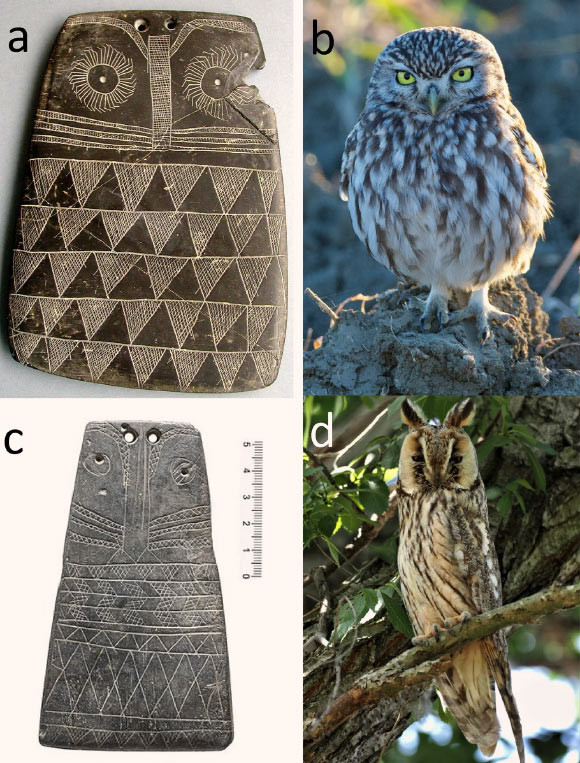In the Copper Age, around 5,000 years ago, owl-shaped, engraved plaques were produced massively in the southwestern corner of the Iberian Peninsula. Researchers have speculated about the function of these palm-sized stone objects for more than a century, although most have favored the idea that they represented goddesses.
Iberian owl-like plaques and local owl species: (a) engraved slate plaque found in Cerro de la Cabeza, Valencina de la Concepción, Sevilla, Spain; (b) wild little owl (Athene noctua) pictured in an agricultural area in Valencina de la Concepción in 2021; (c) slate plaque from Mértola, Alentejo, Portugal; the orifices on the upper part may have been used to insert actual feathers; (d) long-eared owl (Asio otus) with erected ear tufts, pictured in Valencina de la Concepción in 2021. Image credit: Juan J. Negro.
The engraved slate plaques of southwestern Iberia were crafted in a relatively narrow time window about 5,500 to 4,750 years ago, and rank among the most emblematic and unique objects of the Chalcolithic/Copper Age cultural period.
These palm-sized plaques were engraved with geometric patterns and often had a ‘head’ with two round circles generally described as eyes and a ‘body’ below.
Most of them had one or two perforations at the top of the head purportedly used to pass a string.
In addition to the flat slate plaques, similar objects carved in sandstone or in mammal bones such as horse phalanges, have been found, also exhibiting a pair of eyes on one of the extremes.
About 4,000 plaques have been located so far, many in megalithic tombs, but also in pits.
In the new study, CSIC researcher Juan Negro and his colleagues examined 100 Iberian owl-shaped plaques.
They rated the plaques — on a scale of one to six — based on how many of six owl traits they displayed including two eyes, feathery tufts, patterned feathers, a flat facial disk, a beak, and wings.
They compared the artifacts to 100 modern images of owls drawn by children aged 4 to 13 years old, and observed many similarities between the depictions of owls.
Owl drawings more closely resembled owls as children aged and became more skilful.
The authors suggest that two of the most common and widely distributed species in southern Iberia, the little owl (Athene noctua) and the long-eared owl (Asio otus), were the model for a majority of the owl-like plaques.
“We propose that the owl-like slate plaques are the remains of a set of objects used in both playful activities and in ritual ceremonies,” they said.
“The actual engraving of the plaques may have been part of the game.”
“Owlish slate plaques were often perforated twice at the top,” they added.
“We interpret this as insertion points for actual bird feathers added to the plaques, right at the place where tufts emerge in live owls.”
“The frontier among play and ritual is diffuse in liminal societies and there is no contradiction in playing with animal-like toys and, at some point, using them as offerings as part of community rituals related, for instance, to the colossal megalithic tombs so characteristic of the Copper Age.”
The study was published in the journal Scientific Reports.
_____
J.J. Negro et al. 2022. Owl-like plaques of the Copper Age and the involvement of children. Sci Rep 12, 19227; doi: 10.1038/s41598-022-23530-0




